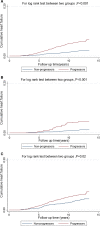Progression of Coronary Artery Calcium and Incident Heart Failure: The Multi-Ethnic Study of Atherosclerosis
- PMID: 28428195
- PMCID: PMC5533017
- DOI: 10.1161/JAHA.116.005253
Progression of Coronary Artery Calcium and Incident Heart Failure: The Multi-Ethnic Study of Atherosclerosis
Abstract
Background: Although the association between coronary artery calcium (CAC) and future heart failure (HF) has been shown previously, the value of CAC progression in the prediction of HF has not been investigated. In this study, we investigated the association of CAC progression with subclinical left ventricular (LV) dysfunction and incident HF in the Multi-Ethnic Study of Atherosclerosis.
Methods and results: The Multi-Ethnic Study of Atherosclerosis is a population-based study consisting of 6814 men and women aged 45 to 84, free of overt cardiovascular disease at enrollment, who were recruited from 4 ethnicities. We included 5644 Multi-Ethnic Study of Atherosclerosis participants who had baseline and follow-up cardiac computed tomography and were free of HF and coronary heart disease before the second cardiac computed tomography. Mean (±SD) age was 61.7±10.2 years and 47.2% were male. The Cox proportional hazard models and multivariable linear regression models were deployed to determine the association of CAC progression with incident HF and subclinical LV dysfunction, respectively. Over a median follow-up of 9.6 (interquartile range: 8.8-10.6) years, 182 participants developed incident HF. CAC progression of 10 units per year was associated with 3% of increased risk of HF independent of overt coronary heart disease (P=0.008). In 2818 participants with available cardiac magnetic resonance images, CAC progression was associated with increased LV end diastolic volume (β=0.16; P=0.03) and LV end systolic volume (β=0.12; P=0.006) after excluding participants with any coronary heart disease.
Conclusions: CAC progression was associated with incident HF and modestly increased LV end diastolic volume and LV end systolic volume at follow-up exam independent of overt coronary heart disease.
Keywords: cardiac computed tomography; cardiac magnetic resonance imaging; coronary artery calcium; coronary artery calcium progression; heart failure.
© 2017 The Authors. Published on behalf of the American Heart Association, Inc., by Wiley.
Figures

Similar articles
-
Resting heart rate as predictor for left ventricular dysfunction and heart failure: MESA (Multi-Ethnic Study of Atherosclerosis).J Am Coll Cardiol. 2014 Apr 1;63(12):1182-1189. doi: 10.1016/j.jacc.2013.11.027. Epub 2014 Jan 8. J Am Coll Cardiol. 2014. PMID: 24412444 Free PMC article.
-
Usefulness of Coronary Artery Calcium to Predict Heart Failure With Preserved Ejection Fraction in Men Versus Women (from the Multi-Ethnic Study of Atherosclerosis).Am J Cardiol. 2017 Nov 15;120(10):1847-1853. doi: 10.1016/j.amjcard.2017.07.089. Epub 2017 Aug 7. Am J Cardiol. 2017. PMID: 28985952
-
Aortic Calcification Onset and Progression: Association With the Development of Coronary Atherosclerosis.J Am Heart Assoc. 2017 Mar 30;6(4):e005093. doi: 10.1161/JAHA.116.005093. J Am Heart Assoc. 2017. PMID: 28360229 Free PMC article.
-
Association of polygenic risk scores with incident atherosclerotic cardiovascular disease events among individuals with coronary artery calcium score of zero: The multi-ethnic study of atherosclerosis.Prog Cardiovasc Dis. 2022 Sep-Oct;74:19-27. doi: 10.1016/j.pcad.2022.08.003. Epub 2022 Aug 8. Prog Cardiovasc Dis. 2022. PMID: 35952728 Free PMC article. Review.
-
Coronary Artery Calcification.Glob Heart. 2016 Sep;11(3):287-293. doi: 10.1016/j.gheart.2016.08.001. Glob Heart. 2016. PMID: 27741976 Free PMC article. Review.
Cited by
-
Growth differentiation factor 15 in adverse cardiac remodelling: from biomarker to causal player.ESC Heart Fail. 2020 Aug;7(4):1488-1501. doi: 10.1002/ehf2.12728. Epub 2020 May 18. ESC Heart Fail. 2020. PMID: 32424982 Free PMC article. Review.
-
Coronary Artery Calcium for Risk Stratification of Heart Failure Mortality: The Coronary Artery Calcium Consortium.J Card Fail. 2025 Jul;31(7):1005-1015. doi: 10.1016/j.cardfail.2024.10.437. Epub 2024 Nov 14. J Card Fail. 2025. PMID: 39547402
-
Association of coronary artery calcification and thoracic aortic calcification with incident peripheral arterial disease in the Multi-Ethnic Study of Atherosclerosis (MESA).Eur Heart J Open. 2021 Dec 3;1(3):oeab042. doi: 10.1093/ehjopen/oeab042. eCollection 2021 Nov. Eur Heart J Open. 2021. PMID: 35005719 Free PMC article.
-
Association of soluble interleukin-2 receptor α and tumour necrosis factor receptor 1 with heart failure: The Multi-Ethnic Study of Atherosclerosis.ESC Heart Fail. 2020 Apr;7(2):639-644. doi: 10.1002/ehf2.12623. Epub 2020 Mar 10. ESC Heart Fail. 2020. PMID: 32155316 Free PMC article.
-
Influence of heart rate on coronary calcium scores: a multi-manufacturer phantom study.Int J Cardiovasc Imaging. 2018 Jun;34(6):959-966. doi: 10.1007/s10554-017-1293-x. Epub 2017 Dec 28. Int J Cardiovasc Imaging. 2018. PMID: 29285727
References
-
- Mozaffarian D, Benjamin EJ, Go AS, Arnett DK, Blaha MJ, Cushman M, Das SR, de Ferranti S, Despres JP, Fullerton HJ, Howard VJ, Huffman MD, Isasi CR, Jimenez MC, Judd SE, Kissela BM, Lichtman JH, Lisabeth LD, Liu S, Mackey RH, Magid DJ, McGuire DK, Mohler ER III, Moy CS, Muntner P, Mussolino ME, Nasir K, Neumar RW, Nichol G, Palaniappan L, Pandey DK, Reeves MJ, Rodriguez CJ, Rosamond W, Sorlie PD, Stein J, Towfighi A, Turan TN, Virani SS, Woo D, Yeh RW, Turner MB. Heart disease and stroke statistics—2016 update: a report from the American Heart Association. Circulation. 2016;133:e38–e360. - PubMed
-
- Liu L, Eisen HJ. Epidemiology of heart failure and scope of the problem. Cardiol Clin. 2014;32:1–8. - PubMed
-
- Johnson FL. Pathophysiology and etiology of heart failure. Cardiol Clin. 2014;32:9–19. - PubMed
MeSH terms
Grants and funding
LinkOut - more resources
Full Text Sources
Other Literature Sources
Medical
Research Materials
Miscellaneous

